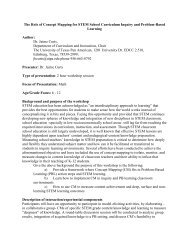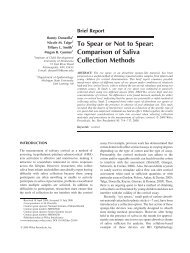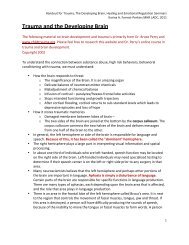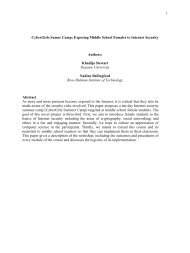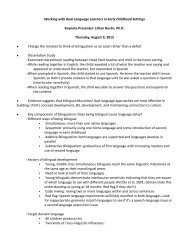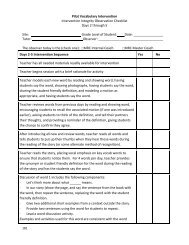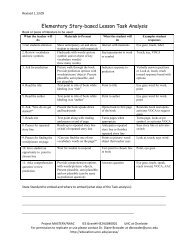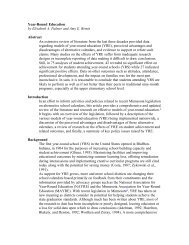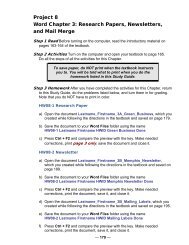Introduction to Positive Ways of Intervening with Challenging Behavior
Introduction to Positive Ways of Intervening with Challenging Behavior
Introduction to Positive Ways of Intervening with Challenging Behavior
Create successful ePaper yourself
Turn your PDF publications into a flip-book with our unique Google optimized e-Paper software.
<strong>to</strong> be completed in order <strong>to</strong> establish which antecedents and consequences are supporting the behavior (or which<br />
antecedents and consequences are needed in the case <strong>of</strong> promoting behavior). Third, it must be determined<br />
whether the target behavior is <strong>of</strong> priority <strong>to</strong> justify intervention. For example, while pencil tapping may be an<br />
annoying behavior, it probably does not warrant implementation <strong>of</strong> a <strong>to</strong>ken economy. In deciding whether a<br />
behavior necessitates intervention, you will need <strong>to</strong> look at its frequency (how <strong>of</strong>ten it occurs as compared <strong>to</strong><br />
peers), the intensity at which the behavior is exhibited, and the rate at which the student is able <strong>to</strong> learn new<br />
behaviors.<br />
After these steps have been taken and it is agreed that a problem which warrants intervention does exist,<br />
behavior modification can be implemented.<br />
What are examples <strong>of</strong> behavior modification interventions?<br />
Examples <strong>of</strong> behavior modification which can be used <strong>to</strong> increase behavior are: praise and approval, modeling,<br />
positive programming, shaping, <strong>to</strong>ken economy, self-moni<strong>to</strong>ring, and shaping. Methods which can be used <strong>to</strong><br />
decrease behavior are: extinction, reinforcing incompatible behavior, relaxation, self-moni<strong>to</strong>ring, and shaping.<br />
What are other considerations <strong>to</strong> take in<strong>to</strong> account when implementing a behavior<br />
modification intervention?<br />
When deciding on an intervention, the least intrusive and restrictive intervention deemed likely <strong>to</strong> be effective<br />
should be chosen. For example, if a student is likely <strong>to</strong> respond <strong>to</strong> verbal praise in increasing assignment<br />
completion behavior, it would be unnecessary, and perhaps even detrimental, <strong>to</strong> implement a <strong>to</strong>ken economy in<br />
changing this behavior.<br />
It is also important <strong>to</strong> include positive programming as part <strong>of</strong> any type <strong>of</strong> behavioral intervention. For many<br />
students, inappropriate behavior may be the only behavior in a student’s reper<strong>to</strong>ire which has been effective in<br />
meeting his or her needs. <strong>Positive</strong> programming serves <strong>to</strong> increase the options in a student’s reper<strong>to</strong>ire and<br />
provide more choices for the student.<br />
Finally, it is important <strong>to</strong> remember that it is the behavior which is troublesome, not the student. It is<br />
important <strong>to</strong> make this distinction even though in some cases a student may seem <strong>to</strong> continually try your patience.<br />
Separating the student from his or her behavior will help prevent and dissipate negative feeling that you may have<br />
about a student and help make you and your intervention more effective.<br />
References<br />
Cangelosi, J.S. (1988). Classroom management strategies: Gaining and maintaining students’ cooperation. New York: Longman, Inc.<br />
Kerr, M.M., & Nelson, C.M. (1989). Strategies for managing behavior problems in the classroom (2nd ed.). New York: MacMillan.<br />
O’Leary, K.D., & O’Leary, S.G. (1977). Classroom management: The successful use <strong>of</strong> behavior modification (2nd ed.). New York:<br />
Pergamon Press Inc.<br />
Zirpoli, T.J., & Mellow, K.J. (1993). <strong>Behavior</strong> management: Applications for teachers and parents. New York: MacMillan.<br />
This publication was supported by Grant #H029K20171, Special Project <strong>to</strong> Provide Technical Assistance, Inservice Training<br />
and Site Development for <strong>Positive</strong> <strong>Behavior</strong>al Support Strategies for Students <strong>with</strong> Disabilities from the U.S. Department <strong>of</strong><br />
Education. The University <strong>of</strong> Minnesota is an equal opportunity employer and educa<strong>to</strong>r.




